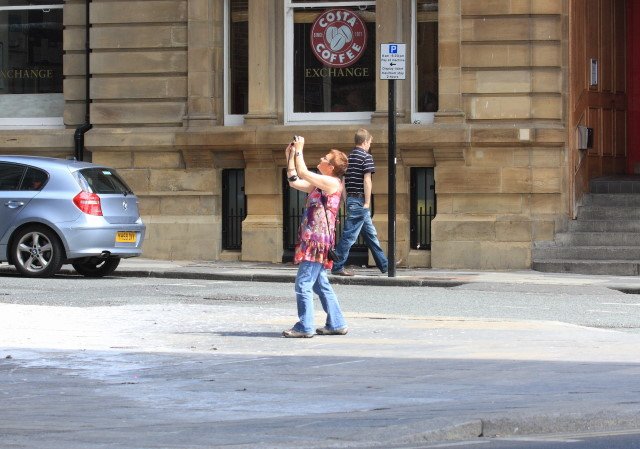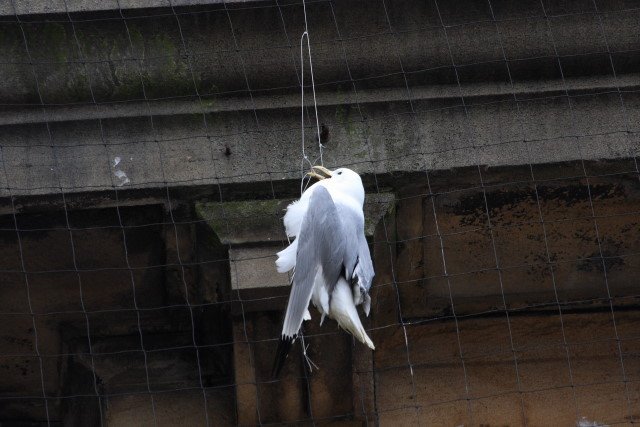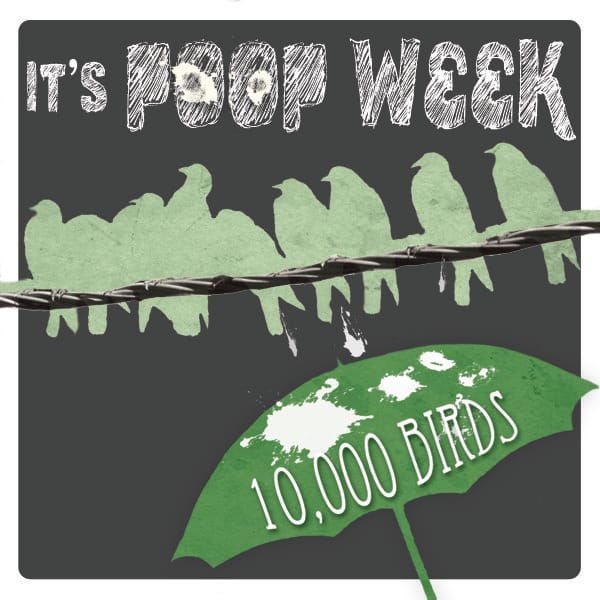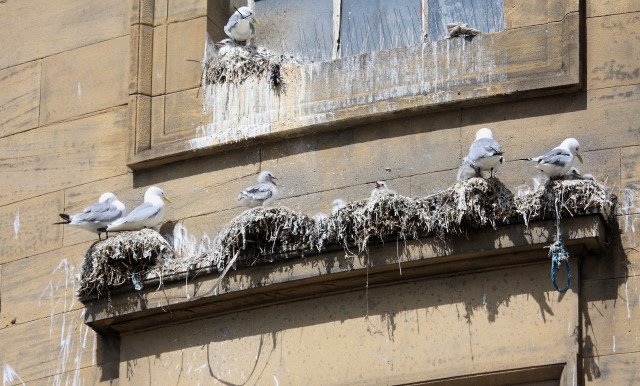not compatible with the aspiration for an outstanding urban waterfront
The city of Newcastle is England’s most northerly, perhaps most famous for not winning very much at football for many years as well as being a big weekend party destination for the young (and those that are still fooling themselves they are). In recent years the city’s Quayside has been redeveloped from a rather tired looking semi-industrial area into a modern waterfront complete with iconic buildings and trendy bars.
The heart of the Quayside is not then a place that you might expect to find a pelagic gull but it is here that for the last forty odd years a small colony of Black-legged Kittiwakes has chosen to nest. The ledges and windows of quayside buildings and the crevices of the vast spans of the iconic Tyne Bridge doubling as cliffs for this pretty little gull.
 Kittiwakes under the Tyne Bridge
Kittiwakes under the Tyne Bridge
The colony has had a difficult relationship at times with developers, a minority of residents and local council officials. It has survived eviction, as a a result of the conversion of one of its original locations (the Baltic Flour Mill) into a ‘world class’ art gallery. The relatively sheltered and safe locations have allowed the colony to prosper and grow. It is unique in that it is the furthest inland Kittiwake colony in the world. Having a pelagic gull that spends much of it’s life at sea in the heart of a vibrant city creates an incredible atmosphere unrivalled in any other British city.
not compatible with the aspiration for an outstanding urban waterfront
Not everyone thinks that the sound of raucous gulls 3 0r 4 months of the year, the faint whiff of fish and a splash of whitewash guano style is a good thing.The council have attempted to dissuade the Kittiwakes from nesting in some locations such as the Guildhall. The spikes in the image below were added to all window ledges, I think in 2009. As can be seen the Kittiwakes have adapted to them rather well using them to fix their nests in place creating something of an own goal.
A recent consultant’s report commissioned by the city council took issue with the colony and its continued spread around quayside buildings including the Grade 1 listed Guildhall. It’s the poo that’s the problem. Actually that’s not true, it’s the lack of tolerance of the poo that’s the problem.
The report and that dismissive quote “not compatible with the aspiration for an outstanding urban waterfront ” highlights exactly where the problem lies for some people. It strikes me that what is really being said here is that in the aspirations to have the ‘outstanding urban waterfront’ that politicians, officials, businesses and other experts are so keen to see, there is obviously no room for anything natural to get in the way and spoil the view. This seems to reflect the huge disconnect we have generally with nature these days, a lack of tolerance towards it and the mantra of economic concerns overriding all. Whoever expressed these concerns appears to have completely missed the fact that it is the birds breeding at the heart of the Quayside that in many ways, visually and aurally, add atmosphere and a connection with the river’s past and natural origins. They are a unique asset to be celebrated and protected in the same way as say the Ravens at the Tower of London.
It seems to me that in the rush for a poo-free city the council and it’s consultants are missing an opportunity. Unique is good, unique sells. I read a comment from an interviewed local shop owner in the regional newspaper along the lines of ” tourists are forced to dodge the mess by taking cover in the shop”. You couldn’t make it up could you? Whilst I genuinely doubt the truth of the statement even if it were true isn’t that what every retail business wants, customers through the door?
In the twenty minutes I was on the quayside on a Monday morning to capture the images for this post I counted ten people who stopped, looked at the colony and took pictures.
 A Tourist appreciating the Kittiwakes
A Tourist appreciating the Kittiwakes
These birds are an integral part of the cityscape and in my view the city council should be working closely with local businesses to see how they can realise economic value from their presence not conspiring with developers and planners to get rid of them.
What is for sure is that the consequences of non-acceptance of their presence by the authorities results in a sad loss of life for some of these precious seabirds. A sad state of affairs all brought about by a little poo.
 Kittiwake trapped in netting designed to prevent nesting
Kittiwake trapped in netting designed to prevent nesting
________________________________________________________________________________________
 Poop Week is a week of themed posts on 10,000 Birds that cover the intersection of poop and birding, a fertile precinct if there ever was one. Rather than just discuss the horror of a pigeon dropping droppings on someone’s head we decided to really get down the nitty-gritty details of poop, to the point where it is squishing up between our toes. Not only is Poop Week a fascinating way to spend seven days in June it is also a serious attempt to elevate the level of discourse in the bird blogosphere, which, as we all have no choice but to admit, is far too low. Enjoy, and make sure to wipe up afterwards, would you?
Poop Week is a week of themed posts on 10,000 Birds that cover the intersection of poop and birding, a fertile precinct if there ever was one. Rather than just discuss the horror of a pigeon dropping droppings on someone’s head we decided to really get down the nitty-gritty details of poop, to the point where it is squishing up between our toes. Not only is Poop Week a fascinating way to spend seven days in June it is also a serious attempt to elevate the level of discourse in the bird blogosphere, which, as we all have no choice but to admit, is far too low. Enjoy, and make sure to wipe up afterwards, would you?
________________________________________________________________________________________














Another example of incompatability of human development with nature conservation. We will continue to exchange forest for concrete and displace all living things to make room for our development.